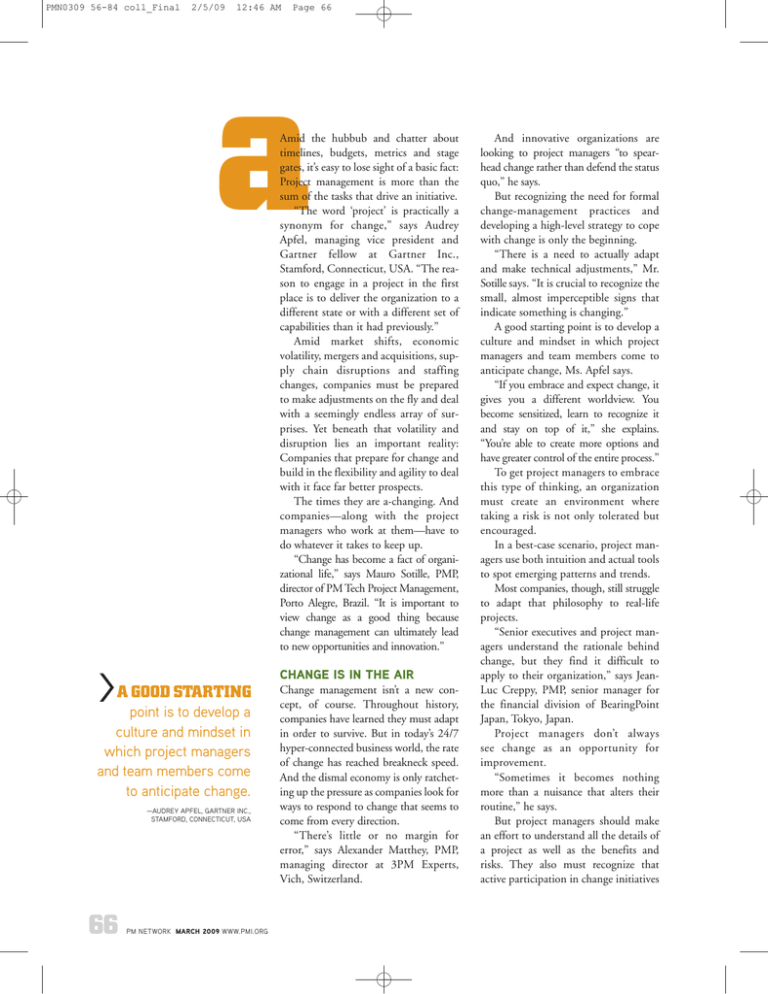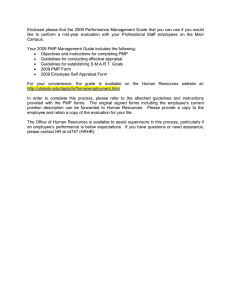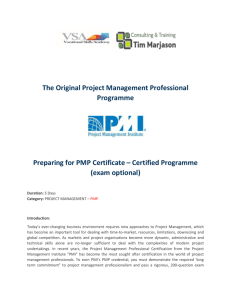A GOOD STARTING point is to develop a culture and mindset in
advertisement

PMN0309 56-84 coll_Final 2/5/09 12:46 AM Page 66 a Amid the hubbub and chatter about timelines, budgets, metrics and stage gates, it’s easy to lose sight of a basic fact: Project management is more than the sum of the tasks that drive an initiative. “The word ‘project’ is practically a synonym for change,” says Audrey Apfel, managing vice president and Gartner fellow at Gartner Inc., Stamford, Connecticut, USA. “The reason to engage in a project in the first place is to deliver the organization to a different state or with a different set of capabilities than it had previously.” Amid market shifts, economic volatility, mergers and acquisitions, supply chain disruptions and staffing changes, companies must be prepared to make adjustments on the fly and deal with a seemingly endless array of surprises. Yet beneath that volatility and disruption lies an important reality: Companies that prepare for change and build in the flexibility and agility to deal with it face far better prospects. The times they are a-changing. And companies—along with the project managers who work at them—have to do whatever it takes to keep up. “Change has become a fact of organizational life,” says Mauro Sotille, PMP, director of PM Tech Project Management, Porto Alegre, Brazil. “It is important to view change as a good thing because change management can ultimately lead to new opportunities and innovation.” CHANGE IS IN THE AIR > A GOOD STARTING point is to develop a culture and mindset in which project managers and team members come to anticipate change. —AUDREY APFEL, GARTNER INC., STAMFORD, CONNECTICUT, USA 66 PM NETWORK MARCH 2009 WWW.PMI.ORG Change management isn’t a new concept, of course. Throughout history, companies have learned they must adapt in order to survive. But in today’s 24/7 hyper-connected business world, the rate of change has reached breakneck speed. And the dismal economy is only ratcheting up the pressure as companies look for ways to respond to change that seems to come from every direction. “There’s little or no margin for error,” says Alexander Matthey, PMP, managing director at 3PM Experts, Vich, Switzerland. And innovative organizations are looking to project managers “to spearhead change rather than defend the status quo,” he says. But recognizing the need for formal change-management practices and developing a high-level strategy to cope with change is only the beginning. “There is a need to actually adapt and make technical adjustments,” Mr. Sotille says. “It is crucial to recognize the small, almost imperceptible signs that indicate something is changing.” A good starting point is to develop a culture and mindset in which project managers and team members come to anticipate change, Ms. Apfel says. “If you embrace and expect change, it gives you a different worldview. You become sensitized, learn to recognize it and stay on top of it,” she explains. “You’re able to create more options and have greater control of the entire process.” To get project managers to embrace this type of thinking, an organization must create an environment where taking a risk is not only tolerated but encouraged. In a best-case scenario, project managers use both intuition and actual tools to spot emerging patterns and trends. Most companies, though, still struggle to adapt that philosophy to real-life projects. “Senior executives and project managers understand the rationale behind change, but they find it difficult to apply to their organization,” says JeanLuc Creppy, PMP, senior manager for the financial division of BearingPoint Japan, Tokyo, Japan. Project managers don’t always see change as an opportunity for improvement. “Sometimes it becomes nothing more than a nuisance that alters their routine,” he says. But project managers should make an effort to understand all the details of a project as well as the benefits and risks. They also must recognize that active participation in change initiatives PMN0309 56-84 coll_Final 2/5/09 12:46 AM is not a choice. It’s the baseline for working at the organization. Yet at the same time, executives should be sure to listen to project managers and team members. “Someone may have a very good reason for resisting things. There could be a real problem,” Mr. Creppy says. “It’s important to find out why and address the issues.” PUTTING CHANGE TO WORK Jihad Jaljouli, PMP, is among those on the front lines of change. As the general manager for ITEC, an Amman, Jordan IT solutions provider, he regularly reviews the company’s risk monitor sheet and holds meetings with relevant managers to discuss and investigate issues. A change board then meets on a monthly basis or upon request to make decisions, he says. Project management change is monitored by the project management office (PMO) on a project-by-project basis, Mr. Jaljouli says. Each change is recorded in a change request template and submitted to the PMO manager to assess whether the process should be handled within the PMO or entered into the risk monitor and addressed by the change board. If the change is initiated by the client, a response must go out no later than 14 days from the reporting date. In the event of a sudden change, the issue is automatically entered into the risk monitor. “If the change impact falls outside the limits of tolerance as specified in the risk monitor or the reporting manager believes it to be of significant impact, then a message is sent by the manager reporting the issue to all members of the change board to alert and request an ad hoc meeting,” Mr. Jaljouli explains. All upper-level managers at ITEC have access to the firm’s risk management program, while lower-level team members receive “change broadcast” notifications through the company’s intranet. IN THE FACE OF UNCERTAINTY Even for those organizations and project managers who say they embrace change, Page 67 it’s not always as simple as ushering in new systems and revamping workflow. Some friction is inevitable—a change in processes and procedures means people have to remap the way they work, how they communicate, who they report to and how work actually gets done. Without accurate information and a real understanding for the project, “people tend to get lost in all the noise,” Mr. Creppy says. It’s not unusual for emotions to dominate. In today’s topsy-turvy economic environment, anxiety and fear too often shape the decision-making process. “There is a lack of trust up and down the organization because people aren’t sure what the future holds and what their future is within the organization,” says Jonathan Gilbert, PMP, director of client solutions at ESI International, an Arlington, Virginia, USA consulting firm. Someone must lead the way—and it’s usually going to take someone at the executive level to make the case for change, the potential benefits and what’s required to make a transition. In many cases, that means a significant cultural adjustment. Many organizations trumpet change but then insist on playing it safe. Project managers and team members may feel as though they’re risking their clout or their job if they make a wrong decision or a project doesn’t unfold as intended. Worse, some organizations get lost in the details. A project can come in on time, on budget and hit all the specifications—and still be a dismal failure if it doesn’t meet the right objectives, Ms. Apfel says. “An organization can follow all the prescribed processes and defined methods for dealing with projects but still find itself in trouble,” she points out. “All the right processes can lead you to the wrong place.” If analysis, metrics or measurement tools are lacking, or if the enterprise isn’t constantly adjusting to ongoing change, it can flounder and fail. left to CHANCE Organizations that lack a cohesive change-management strategy face several potential risks: Loss of organizational capital. Mismanaged change can lead to mismanaged budgets. Team mutiny. Resistance can undermine even the best-planned undertaking. “People tend to fear change, and employees may be reluctant to see their familiar processes thrown out,” says Mauro Sotille, PMP, PM Tech Project Management. Mismatched values. If there’s a lack of harmony and cohesiveness, stakeholders may not be on the same page. Drop in efficiency and productivity. Poorly executed change-management processes mean mismanaged workflow. Scope creep. If change processes aren’t monitored and managed, scope can get tough to wrangle. Loss of data. During any change or transition, information is harder to manage. MARCH 2009 PM NETWORK 67 PMN0309 56-84 coll_Final 2/5/09 12:47 AM putting change TO WORK Here are some tips to help foster change from Mauro Sotille, PMP, PM Tech Project Management: 1 Involve the people related to the change. All key stakeholders must work toward the same vision. Otherwise resistance occurs. 2 Communicate the change. Better yet, show how it’s going to make things better. 3 Develop leadership. The best leader is someone the team can relate to. 4 Assemble a change management team. These people can translate ideas into actions and help change leaders carry out their mission. 5 Provide appropriate training. An organization must constantly develop required competencies in project management and change management. 6 Keep the change alive. Demonstrate results and provide feedback to keep a change initiative on track. 7 Reward success. It keeps motivation up and resistance down. 8 Keep the change on track. Be prepared for the unexpected—and have systems, tools and strategies in place to deal with it. 68 PM NETWORK MARCH 2009 WWW.PMI.ORG Page 68 “The most important question is whether the organization is building greater value and improving its standing,” Ms. Apfel says. DEAL WITH IT Developing a change-oriented mindset requires business leaders to understand the impact of change and craft a strategy that delivers clarity and understanding throughout the organization. Although change is always disruptive, developing a framework to deal with it can transform the entire process from an obstacle to a competitive advantage. A truly changesavvy project management approach can prepare an organization to cope—no matter what shifts and surprises occur. Among other things, this means understanding employee satisfaction, customer satisfaction, perceived value in the marketplace, and the operational benefits of implementing a new project. Companies have to move past a shortterm strategy focused on immediate results and instead keep an eye on “the relationships that make an organization productive,” Mr. Gilbert says. Organizations may have to even tweak human resources policies—including compensation, benefits, rewards and other incentives—to encourage the desired motivation and behavior. For project managers, adopting an “in the trenches” approach can provide valuable clues about what needs to be done and who needs to be addressed, Mr. Gilbert says. “The thing that is often overlooked is that the role of a project manager isn’t simply to oversee deliverables but also serve as a change agent,” he explains. “Those who are out in the field and interacting with others are likely to be far more successful in shaping thinking and actions.” It also means moving beyond the spreadsheet and project management software and into the realm of a more innovative communications structure. Blogs, wikis, social networking tools and other Web 2.0 innovations can help quickly find and spread information and knowledge—all while addressing concerns and problems—at the rapid speed of today’s business world. For dispersed global companies that manage a tangle of business units, cultures and agendas, Web 2.0 tools can help people share innovative solutions, and address problems and concerns as they happen, Mr. Gilbert says. When companies combine those tools with clearly established metrics and a tightly defined change-control process used consistently across the portfolio, he says, they’re in a much better position to deal with all those inevitable surprises and sudden shifts. Ms. Apfel suggests establishing change checkpoints within the overall project management framework— places where the organization is forced to reevaluate all internal and external business assumptions and make new decisions. Companies may need to adopt a system like ITEC’s to log change requests. Without a formalized structure, changes can get lost in the shuffle or people may wind up duplicating efforts. Of course, the ultimate goal is to create alignment across different groups and constituencies and move forward with the knowledge that the enterprise is equipped to deal with the uncertainties of the current project landscape. “When everyone and everything is in sync, the odds of success are greatly enhanced,” Mr. Gilbert says. “It’s possible to be more flexible and agile—without losing track of key goals.” Frequently, he adds, executives and project managers must learn to live with a different solution or approach than what was originally envisioned. In the end, “everyone must be thinking on the same page,” Ms. Apfel explains. “Project management blends people, power and politics. To deliver outstanding results, an organization must have a collective mindset that embraces and manages change and makes it part of the entire organizational fabric.” PM T



